Digital Poster
MRF Acquisition & Reconstruction
ISMRM & ISMRT Annual Meeting & Exhibition • 04-09 May 2024 • Singapore

| Computer # | |||
|---|---|---|---|
3546.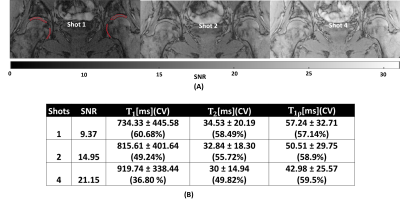 |
1 |
3D Magnetic Resonance Fingerprinting for Rapid Simultaneous
Bilateral T1, T2 and T1ρ Relaxation Mapping of the Hip Joint
Anmol Monga1,
Hector Lise De Moura1,
Richard Kijowski1,
and Ravinder Regatte1
1Radiology, Center for Advanced Imaging Innovation and Research (CAI2R), Department of Radiology, New York Langone Health, New York, NY, United States Keywords: MR Fingerprinting, Osteoarthritis, Bilateral Hip Imaging Motivation: MR Fingerprinting (MRF) can accelerate simultaneous acquisition of multiple quantitative parametric maps with respect to conventional qMRI approaches. Goal(s): To demonstrate the feasibility of 3D bilateral hip MRF to map T1 , T2 and T1ρ in the hip Joint. Approach: 3D MRF maps of bilateral hip were acquired for 6 healthy subjects. Parametric maps estimated are compared against parametric maps estimated from VIBE variable flip angle and Turbo-Flash sequences. Results: Parametric maps obtained from 3D MRF are highly correlated (R-square > 0.89) with parametric maps from reference MRI ; 6.3% - 7.4% variance in 3D MRF parametric maps in repeatability test. Impact: 3D MR Fingerprinting (MRF) can accelerate the acquisition of parametric maps in the hip joint without considerably effecting the accuracy of the parametric maps. |
|
3547.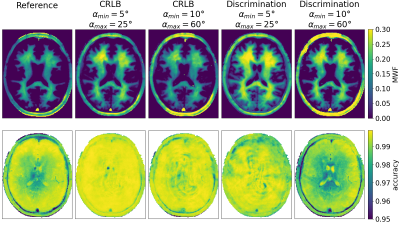 |
2 |
Towards Sequence Optimization for Multi-Compartment Magnetic
Resonance Fingerprinting
Tom Griesler1,2,3,
Maximilian Gram1,4,
Jannik Stebani1,
Petra Albertova1,4,
Peter Dawood1,
Nicole Seiberlich2,3,
Peter Michael Jakob1,
and Martin Blaimer5
1Experimental Physics 5, University of Würzburg, Würzburg, Germany, 2Department of Biomedical Engineering, University of Michigan, Ann Arbor, MI, United States, 3Department of Radiology, University of Michigan, Ann Arbor, MI, United States, 4Department of Internal Medicine I, University Hospital Würzburg, Würzburg, Germany, 5Magnetic Resonance and X-Ray Imaging Department, Division Development Center X-Ray Technology, Fraunhofer Institute for Integrated Circuits IIS, Würzburg, Germany Keywords: MR Fingerprinting, MR Fingerprinting, Myelin
Motivation: Volumetric measurements of the myelin
water fraction in the human brain are hampered by long
acquisition times.
Goal(s): Investigate the extent to which sequence
optimization can improve the encoding efficiency of
multi-compartment Magnetic Resonance Fingerprinting.
Approach: Implement different cost functions to
optimize MRF sequence parameters. Validate the results with
simulations, one-dimensional projection measurements in
phantoms and in vivo measurements.
Results: MRF sequence design has a significant
influence on partial volume estimation with MRF.
Optimization can yield improved tissue discrimination and
more detailed myelin water fraction maps. Impact: MRF sequence design has a significant influence on partial volume estimation, yielding potential for optimization of, for example, tissue discrimination and myelin water fraction mapping. Further investigation of cost functions and validation of results is needed. |
|
3548.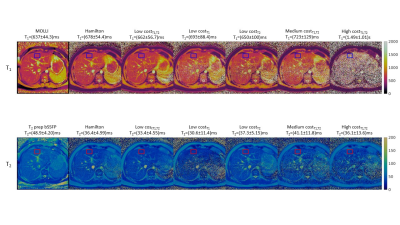 |
3 |
Preparation Scheme Optimization for Abdominal MRF
Tom Griesler1,2,
Jesse Hamilton1,2,
Sydney Kaplan1,2,
Evan Cummings1,2,
Nicole Seiberlich1,2,
and Gastao Cruz2
1Department of Biomedical Engineering, University of Michigan, Ann Arbor, MI, United States, 2Department of Radiology, University of Michigan, Ann Arbor, MI, United States Keywords: MR Fingerprinting, MR Fingerprinting, Abdominal
Motivation: Optimal sequence design for
magnetization-prepared abdominal MRF is largely unexplored.
Optimization could potentially result in reduced scan times
and increased precision and accuracy.
Goal(s): Investigate the predictive power of
CRLB-based cost functions on the performance of
magnetization-prepared MRF sequences.
Approach: Sequences with different preparation
schemes were selected based on CRLB cost functions and
evaluated in simulations and in
vivo experiments. In the resulting T1 and
T2 maps,
precision and accuracy were compared to the relative
performance predictions of the cost functions.
Results: The CRLB depends on selection and placement
of preparation modules and is correlated with the
quantification performance of the resulting sequences.
Impact: Preliminary simulations and experiments
indicate that the CRLB correlates well with precision and
accuracy in magnetization-prepared abdominal MRF, and may be
used for the optimization of these sequences. |
|
3549.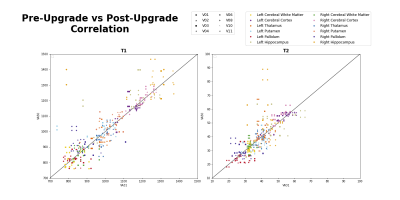 |
4 |
Quantifying Repeatability of a 3D-MRF Protocol During Scanner
Software Upgrades
Andrew Dupuis1,
Yong Chen2,
Mark A Griswold1,2,
and Rasim Boyacioglu2
1Biomedical Engineering, Case Western Reserve University, Cleveland, OH, United States, 2Radiology, School of Medicine, Case Western Reserve University, Cleveland, OH, United States Keywords: MR Fingerprinting, MR Fingerprinting, Repeatability, Upgrade, Regional Analysis, MNI Motivation: Magnetic Resonance Fingerprinting relies on the stable performance of vendor hardware and software through-time. However, the effects of software upgrades on the repeatability of quantitative protocols require evaluation. Goal(s): Measure changes to MRF-derived T1 and T2 values resulting from a vendor-provided software upgrade. Approach: 8 healthy volunteers were imaged before and after a software upgrade. Regional T1 and T2 changes were evaluated using correlation plots and MNI-derived regional means. Results: The evaluated sequence was similarly repeatable in both the intra-version test-retest case (T1: -0.49+/- 3.85%, T2: -0.53+/-7.59%) and pre- to post-upgrade (T1: -0.01+/-4.23% , T2: -2.10+/-8.44%). Impact: Showing similar repeatability of 3D MRF maps before and after vendor software upgrade establishes performance reliability. The automated analysis pipeline does not require qualitative images and can be used to test MRF reproducibility in various stages of longitudinal studies. |
|
3550.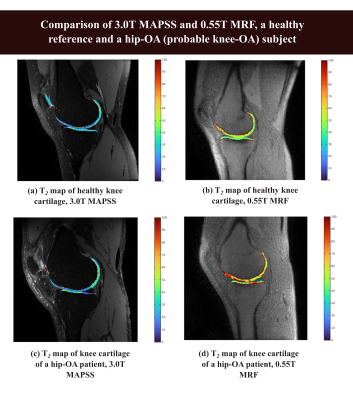 |
5 |
Feasibility of Knee MR Fingerprinting at 0.55T and comparison
with 3.0T MAPSS: Hip-OA cohort with probable early knee
cartilage-loss
Rupsa Bhattacharjee1,
Xiaozhi Cao2,3,
Congyu Liao2,3,
Zheren Zhu1,
Zhitao Li2,
Sharmila Majumdar1,
Kawin Setsompop2,3,
and Yang Yang1
1Department of Radiology & Biomedical Imaging, University of California, San Francisco (UCSF), San Francisco, CA, United States, 2Department of Radiology, Stanford University, Stanford, CA, United States, 3Department of Electrical Engineering, Stanford University, Stanford, CA, United States Keywords: MR Fingerprinting, Low-Field MRI Motivation: Low-cost 0.55T-scanners pose an excellent opportunity to formulate efficient, fast, and quantitative T2 mapping methods that could enhance the reach of early OA-diagnosis. Goal(s): To analyze the feasibility of a novel, fast, and high-resolution MRF-scanning technique to quantify knee cartilage-T2 overcoming the low SNR and inefficient gradient systems at 0.55T and compare against the MAPSS approach at 3.0T. Approach: A suite of techniques was leveraged for MRF, including an optimized-sampling-trajectory, subspace-reconstruction, locally-low-rank-constraint, gradient-waveform-correction, Cramer-Rao-Lower-Bound (CRLB)-optimization for flip-angle-patterns, motion-correction, and deep-learning-based-denoising. Results: The average T2 increase at 0.55T compared to 3.0T provides a wider range for the depiction of granular regions of elevated cartilage-T2 Impact: In this study, advanced techniques including CRLB-optimization, gradient trajectory correction, subspace reconstruction, attention-based denoising, and motion correction were included to demonstrate the feasibility and benefits of a faster, higher-resolution Knee MRF acquisition on a cost-effective 0.55T scanner compare with 3.0T MAPSS. |
|
3551.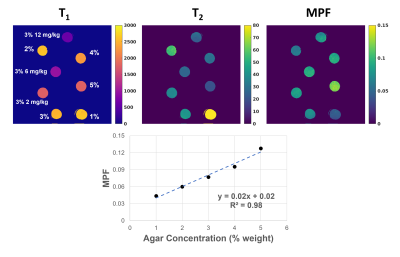 |
6 |
Magnetization Transfer Magnetic Resonance Fingerprinting Using
Spin Lock Preparations
Cory R Wyatt1,2,
Thomas M Barbara2,
and Alexander R Guimaraes1,2
1Diagnostic Radiology, Oregon Health and Science University, Portland, OR, United States, 2Advanced Imaging Research Center, Oregon Health and Science University, Portland, OR, United States Keywords: MR Fingerprinting, MR Fingerprinting, Magnetization Transfer Motivation: Magnetization transfer (MT) techniques allow for quantitative measurement of the macromolecular proton fraction (MPF) of tissues. However, the process of measuring these MT parameters can be lengthy and require many assumptions of T1 and T2. Goal(s): In this study, a magnetic resonance fingerprinting sequence is proposed that acquires T1, T2, and MPF using spin lock preparations. Approach: An MRF sequence was created using spin lock preparations of various off-resonance frequencies to create MT contrast. The sequence was acquired in agarose phantoms and the human brain. Results: Results showed increased MPF with increasing agarose concentration and in white matter. Impact: This study demonstrates the effectiveness of using spin lock pulses for magnetization transfer MRF and allow for quick acquisition of MPF maps that are corrected for the T1 and T2 of the tissue. |
|
3552.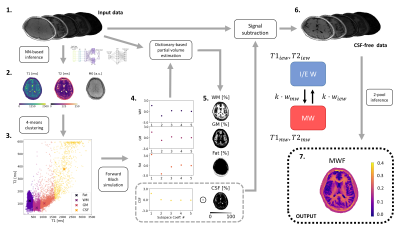 |
7 |
MR Fingerprinting-based myelin water fraction: stability,
spatial consistency and sensitivity to alterations in pediatric
leukodystrophies
Marta Lancione1,
Matteo Cencini2,
Elena Scaffei1,
Emilio Cipriano1,3,
Guido Buonincontri1,
Rolf F. Schulte4,
Carolin M. Pirkl4,
Bianca Buchignani1,
Rosa Pasquariello1,
Raffaello Canapicchi1,
Roberta Battini1,5,
Laura Biagi1,
and Michela Tosetti1
1IRCCS Stella Maris Foundation, Pisa, Italy, 2INFN Pisa Division, Pisa, Italy, 3Department of Physics, University of Pisa, Pisa, Italy, 4GE HealthCare, Munich, Germany, 5Department of Clinical and Experimental Medicine, University of Pisa, Pisa, Italy Keywords: MR Fingerprinting, MR Fingerprinting, Myelin Water Fraction, White Matter Motivation: Multicomponent Magnetic Resonance Fingerprinting (MRF) provides Myelin Water Fraction (MWF) maps in clinically-compatible scan time. However, it still requires validation and assessment of sensitivity and robustness. Goal(s): We aimed to assess MWF stability to model parameters variations, its spatial consistency in healthy children, and sensitivity to alterations in leukodystrophies. Approach: Two-pool relaxation times and exchange were varied in a 10% range. MWF profiles were computed in main WM tracts. MWF sensitivity to alterations was compared to FA, R1, and R2. Results: Model parameters changes led to minimal MWF variations. MWF revealed consistent spatial patterns in controls and showed the highest sensitivity to pathology. Impact: MRF provides robust and sensitive measurements of MWF. As it also allows the simultaneous acquisition of high-resolution R1 and R2 maps in a short scan time, it may represent a clinically-applicable metric to assess and monitor WM disorders. |
|
3553.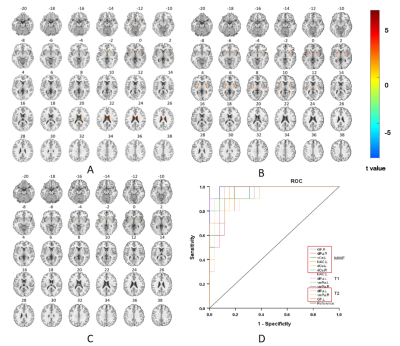 |
8 |
MR Fingerprinting Enables Quantitative Measures of Basal Ganglia
TissueRelaxation Times and Myelin Water Fraction in Parkinson's
Disease
Xiaolu Li1,
Mengwan Zhao1,
Yueluan Jiang2,
and Guoguang Fan1
1Department of Radiology, the first hospital of China medical University, ShenYang, China, 2MR Research Collaboration, Siemens Healthineers, Beijing China, Beijing, China Keywords: MR Fingerprinting, MR Fingerprinting, Parkinson's Disease, basal ganglia, Relaxometry, Myelin water fraction imaging Motivation: The diagnosis and monitoring of PD present formidable challenges due to the absence of objective and specific indicators. Goal(s): Our objective is to demonstrate the potential of MRF in improving PD diagnosis and monitoring, offering a more precise and objective assessment for the benefit of patients. Approach: MRF sequences were used to quantitative brain tissue properties. By employing partial least squares and Receiver Operating Characteristic analysis, we explored MRF's potential in distinguishing PD and assessing disease severity. Results: MRF sequences yield objective and quantifiable metrics for differentiation and severity assessment in PD patients. Impact: By providing reliable objective and quantifiable metrics, the use of MRF enhances the accuracy and reliability of PD assessment, leading to more precise interventions. This has the potential to improve patient outcomes and reduce the burden on healthcare systems. |
|
3554.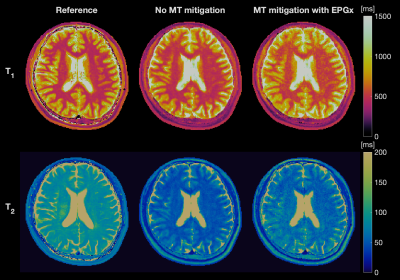 |
9 |
Evaluating 0.55T FISP MRF using EPG-X Formalism
Zhibo Zhu1 and
Krishna S. Nayak1
1Ming Hsieh Department of Electrical and Computer Engineering, University of Southern California, Los Angeles, CA, United States Keywords: MR Fingerprinting, MR Fingerprinting, Magnetization transfer effect Motivation: MT effects influence MRF T1 and T2 quantifications and are stronger at lower field strength. Goal(s): To evaluate the impact of EPGx dictionary generation on relaxometry performance for 0.55T FISP MRF. Approach: We applied the EPG-X formalism with a two-pool model which incorporates MT parameters for dictionary simulation for 0.55T FISP MRF and covered a range of realistic MT parameters values. We applied the approach on 4 healthy subjects. Results: Use of EPGx reduced T2 bias (compared to single-echo spin echo) by 25% at a cost of 80% worse precision. Impact: Simulating dictionary using the EPG-X formalism with a two-pool model can partially mitigate MT effects and may reduce T2 bias. |
|
3555.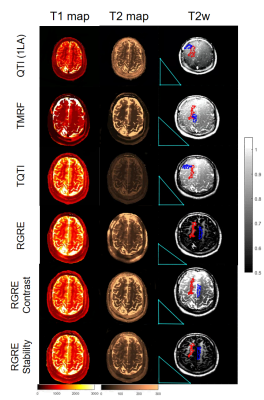 |
10 |
Tailored Synthetic and Non-Synthetic (SNS) Optimization for
pediatric neuroimaging
Tiago Timoteo Fernandes1,
Enlin Qian2,
Pavan Poojar3,
Rita G. Nunes1,
and Sairam Geethanath3
1Institute for Systems and Robotics - Lisboa and Department of Bioengineering, Instituto Superior Técnico – Universidade de Lisboa, Lisboa, Portugal, 2Columbia Magnetic Resonance Research Center, Columbia University, New York, NY, United States, 3Accessible Magnetic Resonance Laboratory, Biomedical Imaging and Engineering Institute, Department of Diagnostic, Molecular and Interventional Radiology, Icahn School of Medicine at Mount Sinai, New York, NY, United States Keywords: MR Fingerprinting, MR Fingerprinting, Synthetic Imaging; Non-synthetic Imaging; Motivation: Quantitative MR (qMR) relaxometry allows monitoring of pediatric neuropathology. However, acquiring qualitative and qMR imaging is time-consuming and challenging, especially in pediatric patients. Goal(s): To design a pulse sequence allowing both quantitative and non-synthetic weighted imaging, addressing the need for acceleration. Approach: MR Fingerprinting (MRF) is the gold standard for simultaneous qMR mapping but does not provide non-synthetic images. We compare MRF versions to sequences designed using the 1-Look-Ahead approach to optimize gray (GM) to white matter (WM) contrast, including periods of stable signal for non-synthetic imaging. Results: A promising signal control enabling quantitative mapping and good-quality weighted in vivo images. Impact: Demonstration of the feasibility of controlled contrast and signal stability for quantitative and qualitative Magnetic Resonance Fingerprinting using one-look ahead (1LA) flip angle design for accelerated scanning in the pediatric brain, increasing quality in T2-weighted images. |
|
3556.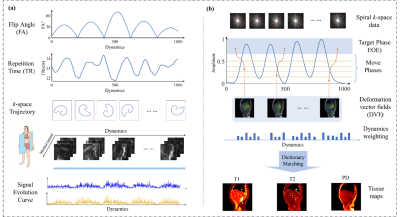 |
11 |
Motion-robust Three-dimensional Magnetic Resonance
Fingerprinting (MR-3DMRF) for Quantitative Abdominal Imaging
Chenyang Liu1,
Lu Wang1,
Peng Cao2,
Tian Li1,
and Jing Cai1
1Department of Health Technology and Informatics, The Hong Kong Polytechnic University, Hong Kong, China, 2Department of Diagnostic Radiology, The University of Hong Kong, Hong Kong, China Keywords: MR Fingerprinting, MR Fingerprinting, Motion Correction Motivation: Current abdominal magnetic resonance fingerprinting (MRF) techniques require breath-hold acquisition to avoid motion artifacts, which is difficult for patients with breathing difficulties. Goal(s): This study aims to develop a motion-robust three-dimensional MRF (MR-3DMRF) technique for abdominal patients and evaluate the repeatability of tissue property quantification. Approach: MR-3DMRF incorporates a non-smooth motion modeling method and a dynamic weighting strategy to allow free-breathing MRF acquisition and motion-resolved reconstruction. Results: Full-width half-maximum of organ boundaries in MR-3DMRF-derived tissue maps is 3.1mm±1.8mm, significantly lower than motion-blurred tissue maps (10.1mm±4.3mm). The linearity of test-retest MRF measurement for T1, T2, and PD was 0.982, 0.894, 0.925, respectively. Impact: This study, for the first time, investigates the feasibility of free-breathing MRF acquisition and motion-resolved MRF reconstruction on abdominal patients. The MR-3DMRF-derived tissue map are highly repeatable and accurate, potentially contribute to abdominal disease diagnosis and treatment assessment. |
|
3557.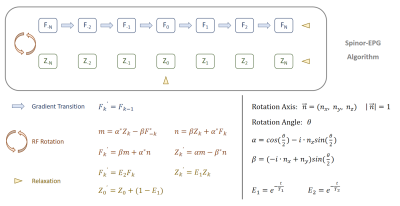 |
12 |
Spinor-EPG: an improved EPG algorithm for fast simulation of the
non-ideal slice-profile effect in MRF
Zhongsen Li1,
Jing Zou1,
Chuyu Liu1,
and Rui Li1
1Tsinghua University, Beijing, China Keywords: MR Fingerprinting, MR Fingerprinting, simulation, slice-profile Motivation: Non-ideal RF slice-profile can affect the accuracy of MRF. However, correcting this effect in dictionary simulation is time-consuming. Goal(s): To propose an improved simulation algorithm which can correct the RF slice-profile effect in MRF simulation accurately and efficiently. Approach: We propose an improved MRF simulation method which combines the spinor rotation representation and the extended-phase-graph(EPG) algorithm. The proposed method is validated by retrospective experiments on brain T1 and T2 maps, compared with the EPG algorithm. Results: The proposed method can correct the non-ideal slice profile effect in MRF dictionary simulation with much faster computational speed. Impact: We propose an improved simulation algorithm for MRF simulation, which is able to correct non-ideal slice-profile and is as efficient as the EPG algorithm. The proposed method may be helpful for all kinds of MRF imaging applications. |
|
3558.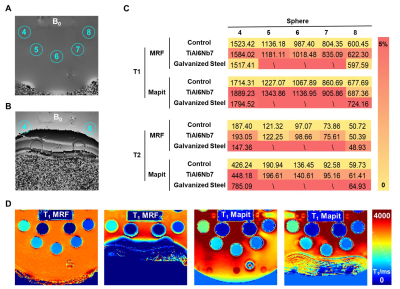 |
13 |
Influence of Medical Implants in the Subcranial and Facial Area
on the Accuracy of Quantitative Magnetic Resonance Relaxometry
at 3T
Gaoyang Zhao1,
Shanshan Zhao1,
Wenzheng Luo2,
Yanglei Wu3,
Feng Chen4,
Yong Zhang1,
and Jingliang Cheng1
1Department of MRI, The First Affiliated Hospital of Zhengzhou University, Zhengzhou, China, 2Department of Neurosurgery, The First Affiliated Hospital of Zhengzhou University, Zhengzhou, China, 3MR Research Collaboration, Siemens Healthineers, Beijing, China, 4Department of Radiology, Hainan General Hospital, Haikou, China Keywords: MR Fingerprinting, Precision & Accuracy, Medical Implants in MRI Motivation: The emergence of MR fingerprinting (MRF) technology enables accurate T1 and T2 relaxation time quantification. However, the impact of metal implants on quantitative imaging remains unclear, hindering postoperative and clinical MRI scans. Goal(s): To assess how craniofacial metal implants affect T1 and T2 relaxation time quantification using MRF at 3T. Approach: We conducted experiments on standardized MRI phantoms (ISMRM/NIST) with cranial implants using MRF and traditional T1/T2 mapping sequences. Results: Aneurysm clips had no significant impact on MRF, while cranial plates/screws exhibited mild abnormalities. Galvanized steel strips caused substantial signal anomalies. Impact: Highlighting the importance of considering the influence of metal implants on quantitative MRI results, impacting the accuracy of diagnoses. This research opens the door to further investigations into the development of metal-insensitive MRI sequences. |
|
3559. |
14 |
Scalable Zero-Shot Self-Supervised Learning for Accelerated MR
Fingerprinting
Yilin Liu1,
Yong Chen2,
and Pew-Thian Yap3
1University of North Carolina at Chapel hill, Chapel Hill, NC, United States, 2Case Western University, Chapel Hill, NC, United States, 3University of North Carolina at Chapel Hill, Chapel Hill, NC, United States Keywords: MR Fingerprinting, MR Fingerprinting, deep learning
Motivation: Collecting ground truth tissue property
maps for training deep learning networks for MR
Fingerprinting reconstruction can be challenging.
Goal(s): We aim to reduce reliance on training
datasets for deep learning based MR Fingerprinting.
Approach: We propose a novel zero-shot
self-supervised MRF framework that requires only the
undersampled k-space measurements. We develop strategies to
rapidly retrieve fingerprints from the dictionary for
efficient network training.
Results: Our method demonstrates promising results on
2x and 4x accelerated MRF without requiring supervised
learning based on ground truth tissue property maps,
laborious reconstruction, explicit dictionary matching, and
network pre-training. Impact: Our preliminary results validated the feasibility of zero-shot self-supervised MRF reconstruction from undersampled MRF data with the help of physics-based constraints. |
|
3560.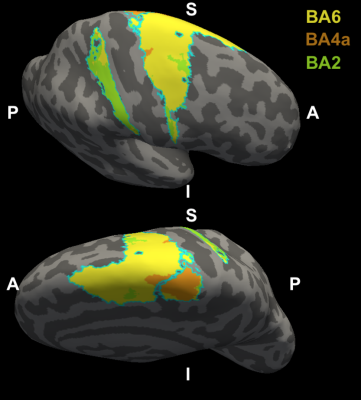 |
15 |
Unsupervised individual-specific in vivo parcellation of the
human cerebral cortex using magnetic resonance fingerprinting
Shahrzad Moinian1,
Viktor Vegh1,2,
and David Reutens1,2
1Australian Institute for Bioengineering and Nanotechnology, The University of Queensland, Brisbane, Australia, 2ARC Training Centre for Innovation in Biomedical Imaging Technology, The University of Queensland, Brisbane, Australia Keywords: MR Fingerprinting, Tissue Characterization Motivation: In vivo MR image resolution limitations hinder precise characterization of individual gray matter microstructure. Addressing this unmet need can particularly enhance neurosurgery precision and assist neurological disorder monitoring. Goal(s): We aimed to investigate the feasibility of developing an unsupervised method for individual-specific voxel-wise cortical mapping by extending the MR fingerprinting (MRF) residual analysis framework. Approach: We employed k-shape clustering to leverage the wealth of cortical area-specific microstructural information in voxel-wise MRF residual timeseries for training an unsupervised model. Results: High sensitivity (75.7%) and specificity (88.3%) of our method demonstrated the feasibility of unsupervised in vivo microstructural cortical mapping using on MRF residual signals. Impact: Our unsupervised MR fingerprinting residual-based method offers a transformative approach to individual-specific human cortical mapping, potentially enhancing neurosurgical precision and neurological disorder diagnosis. This lays the foundation for exploring novel questions in microstructural neuroimaging and cerebral cortex developments in individuals. |
|
3561.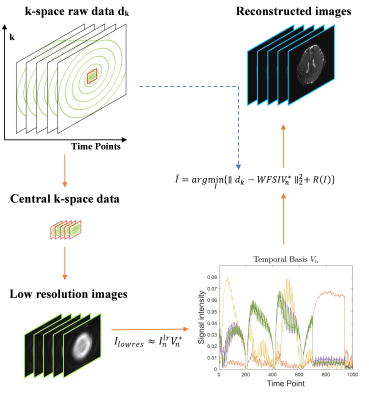 |
16 |
Partial Diffusion-weighted MR Fingerprinting for the
simultaneous quantification of relaxation time and diffusion
coefficient
Yiang Wang1,
Elaine Y.P. Lee1,
and Peng Cao1
1Department of Diagnostic Radiology, The University of Hong Kong, Hong Kong, China Keywords: MR Fingerprinting, Image Reconstruction Motivation: Subspace reconstruction has the potential to generate high-resolution images from highly undersampled data at each time point. Goal(s): To develop an MRF-based approach to simultaneously measure relaxation time and diffusion coefficient. Approach: This sequence was composed of two parts: conventional MRF and DW-SSFP. The central k-space was fully sampled, and the peripheral k-space was under sampled with 24 interleaves, using a dual density spiral trajectory. The subspace reconstruction was applied using the temporal basis obtained from central k-space data. Results: T1, T2, PD, and ADC can be accurately quantified for both phantom and in-vivo scans. Impact: This work indicate that full-resolution DWI can be reconstructed at each time point for a multi-shot multi-dynamic sequence using the subspace reconstruction. Our proposed sequence can be used to estimate relaxation time, proton density and diffusion coefficient simultaneously. |
|
The International Society for Magnetic Resonance in Medicine is accredited by the Accreditation Council for Continuing Medical Education to provide continuing medical education for physicians.